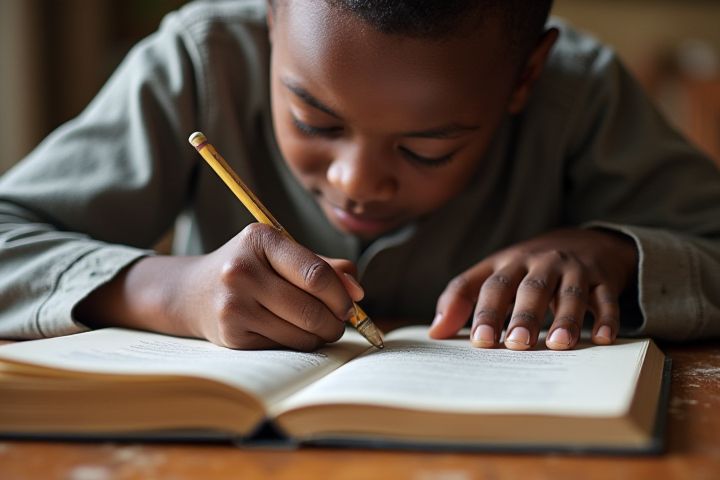
Literacy in Nigeria stands at approximately 62%, with significant disparities between urban and rural areas. The country has made strides in educational initiatives, yet challenges such as inadequate infrastructure and limited access continue to hinder progress, especially for girls. The Nigerian government, along with various NGOs, is actively working to improve literacy through programs focusing on adult education and skill acquisition. English serves as the primary language of instruction, reflecting Nigeria's colonial history and its status as the official language. Investing in literacy not only enhances individual potential but also fosters economic development and social cohesion within diverse communities.
Literacy rate statistics
Nigeria's literacy rate stands at approximately 62.02%, with significant disparities between urban and rural areas. The North has lower literacy levels, often below 50%, while Southern regions exceed 70%, reflecting cultural and economic factors that influence educational access. In 2023, national initiatives aimed at improving literacy, particularly among women and children, have gained momentum, with emphasis on adult education programs. These efforts are essential for fostering economic development and promoting social equity in a country with a diverse population exceeding 200 million.
Gender disparities
Literacy in Nigeria exhibits significant gender disparities, with female literacy rates trailing behind those of males in various regions. According to recent statistics, approximately 60% of women are illiterate compared to 40% of men, highlighting the challenges faced by girls in accessing education. Cultural norms, economic barriers, and early marriage contribute to this gap, restricting women's opportunities for personal and professional growth. Addressing these inequalities is crucial for Nigeria's socio-economic development and empowering women to participate fully in society.
Urban vs rural differences
Literacy rates in Nigeria demonstrate a stark contrast between urban and rural areas, with urban centers typically exhibiting higher levels of education and access to learning resources. In cities like Lagos and Abuja, educational infrastructure, including schools and libraries, fosters an environment conducive to literacy development, supported by government and non-governmental initiatives. Conversely, rural regions face significant challenges, such as limited access to schools, inadequate teaching materials, and socio-economic factors that hinder educational attainment. You can see how these disparities impact overall literacy rates, contributing to a cycle of poverty and limited opportunities in rural communities compared to their urban counterparts.
Educational infrastructure
Educational infrastructure in Nigeria plays a crucial role in enhancing literacy rates, as it encompasses essential facilities such as classrooms, libraries, and technology access. Many regions face challenges of inadequate school buildings and resources, impacting students' learning experiences and opportunities. Government initiatives and non-governmental organizations are increasingly investing in developing and upgrading educational facilities to promote a conducive learning environment. By improving these infrastructures, you can help foster better literacy outcomes and empower future generations.
Government literacy programs
Government literacy programs in Nigeria aim to enhance the reading and writing skills of its diverse population, addressing the high rates of illiteracy that hinder economic growth and social development. Initiatives like the National Literacy Policy and the Universal Basic Education program seek to ensure access to quality education for both children and adults, particularly in rural areas. These programs often incorporate local languages and culturally relevant materials to support effective learning and retention. By investing in education and literacy, the Nigerian government endeavors to empower citizens, improve employability, and foster civic engagement.
Role of NGOs
Non-governmental organizations (NGOs) play a crucial role in enhancing literacy levels in Nigeria by implementing educational programs tailored to local communities. They provide resources, training, and support to teachers, promoting innovative teaching methods that engage students effectively. Many NGOs also focus on adult literacy initiatives, empowering individuals with essential reading and writing skills to improve their personal and professional lives. By collaborating with government agencies and private sectors, these organizations create sustainable frameworks that address the barriers to education in Nigeria.
Language barriers
In Nigeria, literacy rates are significantly impacted by diverse language barriers, as the country is home to over 500 languages, including Hausa, Yoruba, and Igbo. These linguistic differences create challenges in accessing educational resources, hindering comprehension and effective communication in classrooms. Children who speak indigenous languages often struggle to learn in English, the official language, which can lead to lower academic achievement and increased dropout rates. To improve literacy, initiatives that promote multilingual education and the incorporation of local languages into curricula are essential for bridging these gaps and enhancing learning outcomes.
Economic impact
Literacy in Nigeria is a critical driver of economic development, significantly enhancing workforce productivity and innovation. The nation faces a literacy rate of approximately 62%, which underscores the urgent need for educational reforms to empower citizens with essential skills. Improved literacy contributes to higher income levels and poverty reduction, as educated individuals are better equipped for skilled jobs and entrepreneurship. Investing in literacy programs not only fosters individual growth but also stimulates overall economic progress, leading to a more robust and competitive national economy.
Digital literacy initiatives
In Nigeria, digital literacy initiatives are crucial for empowering individuals to navigate the increasingly digital landscape. Programs aimed at enhancing digital skills target various demographics, including students, entrepreneurs, and rural communities, bridging the digital divide. These initiatives often include training sessions on basic computer skills, internet usage, and online safety, enabling participants to harness technology for education and economic opportunities. By fostering digital literacy, Nigeria aims to improve overall literacy rates and promote innovation in a rapidly changing global economy.
School enrollment trends
School enrollment trends in Nigeria reveal significant fluctuations influenced by factors such as socioeconomic status and regional disparities. According to the National Bureau of Statistics, primary school enrollment has shown a gradual increase, yet secondary education remains a challenge, particularly in northern regions where cultural barriers persist. Efforts by the Nigerian government and various NGOs aim to boost enrollment rates through initiatives like the Universal Basic Education program, which emphasizes free and compulsory education for children. By understanding these trends, you can better appreciate the ongoing challenges and opportunities in enhancing literacy across the nation.
